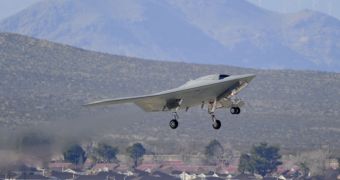On February 4, officials from the United States Navy and Northrop Grumman witnessed the maiden flight of a new airborne system. The aircraft was developed to meet the Navy's requirements for the new war zones it's currently engaged in.
People who saw the X-47B Unmanned Combat Air System Demonstration (UCAS-D) aircraft soaring to the skies in the new maiden flight told reporters that the system could make its way onto aircraft carriers by 2013. The X-47B was developed specifically for this purpose.
Its first flight took place on February 4, from a runway at the Edwards Air Force Base (EAFB), in California. The aircraft took off at 2 pm PST (2200 GMT) and lasted for about 29 minutes.
During this time, controllers proved the capabilities of the unmanned aircraft, by taking it to an altitude of about 5,000 feet (1,525 meters). Once there, they started flying in several types of patterns, while at the same time testing the system's guidance and navigation software.
What is really innovative about this aircraft is the fact that it performs aerodynamic control without a tail. This is one of the first UAV ever to feature this design. Without a tail, stability becomes an issue, but the new aircraft handled itself remarkably.
“Designing a tailless, fighter-sized unmanned aircraft from a clean sheet is no small feat. Commitment, collaboration and uncompromising technical excellence among the Navy, Northrop Grumman and the UCAS-D team industry partners made today's flight a reality,” said Janis Pamiljans.
He is a vice-president at Northrop Grumman and also the UCAS-D program manager at the corporation. “The Northrop Grumman-led UCAS-D industry team is honored to have given wings to the Navy's vision for exploring unmanned carrier aviation,” the official adds.
In addition to the actual flight, the X-47B was also subjected to a variety of other assessments as well, such as for example proof load tests, propulsion system accelerated mission tests, software maturity and reliability simulations and full system taxi tests.
“First flight represents the compilation of numerous tests to validate the airworthiness of the aircraft, and the robustness and reliability of the software that allows it to operate as an autonomous system and eventually have the ability to take off and land aboard an aircraft carrier,” Capt. Jaime Engdahl said.
He is the UCAS-D program manager at the US Navy. The expert says that the new aircraft is about ¾ the length of a F-16 fighter, at 13 meters. It has a wingspan of 21 meters (62 foot). This is a really big unmanned aerial vehicle, Navy officials add.
Arguably, one of the most interesting things about the X-47B is that it has stealth capabilities, which means that enemies the US Navy engages will have a very hard time tracking the probe down.

 14 DAY TRIAL //
14 DAY TRIAL //